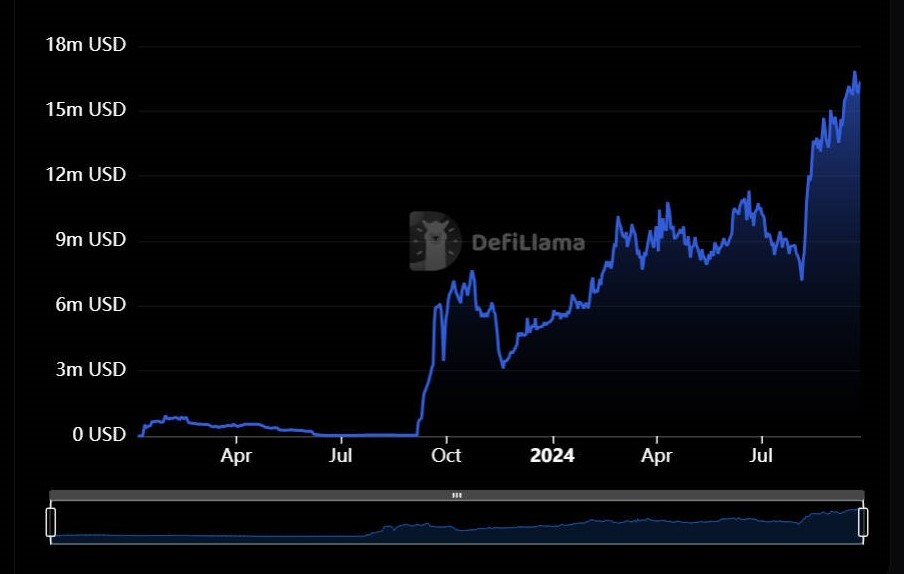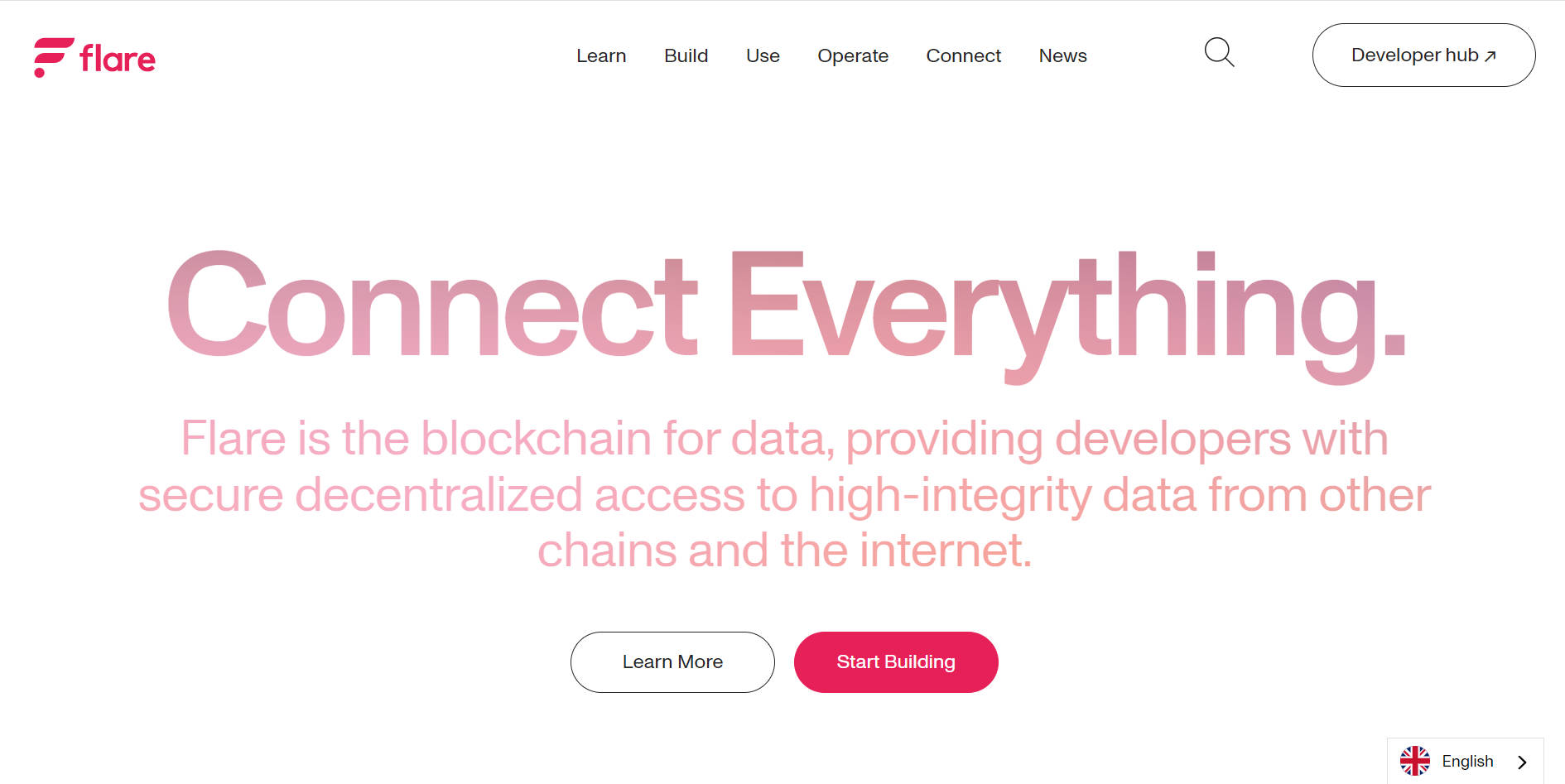
Author: Weilin, PANews
According to Defillama, the Total Value Locked (TVL) of Flare, a Layer 1 blockchain centered around data, has recently climbed to $16.85 million, setting a new historical high. Additionally, Flare's user base is rapidly expanding, reaching 1 million wallet addresses, with approximately 150,000 daily active users. More users in the ecosystem are beginning to show interest and contribute liquidity.
At TOKEN2049 held in Singapore, Flare's co-founder and CEO Hugo Philion shared with PANews the driving forces behind the TVL achievement, why Flare's slogan changed from "Scalable Smart Contract Platform" to "Blockchain of Data," and the current challenges faced by oracle systems. Furthermore, Hugo shared Flare's recently released research exploring how to leverage consensus learning to improve the accuracy of artificial intelligence (AI) and reduce risks.
He revealed that Flare has some exciting things coming up. Currently, Flare is expanding its DeFi ecosystem, planning to launch FAssets, FBTC, and FXRP, while implementing Trusted Execution Environment (TEE) strategies to help developers build better user experiences and applications.
TVL Sets New Historical High

As an EVM-based Layer 1 blockchain, Flare aims to achieve robust interoperability. The Flare network employs two open native interoperability protocols: State Connector and Flare Time Series Oracle (FTSO), supporting on-chain decentralized access to blockchain data and time series data (such as asset prices, data indices, etc.).
In February of this year, Flare completed a $35 million private fundraising round, with participants including Kenetic and Aves Lair. Many interesting dApps have also emerged in the Flare ecosystem, including the lending market Kinetic and the AI-driven DEX Sparkdex. Hugo pointed out that the reason for the TVL surpassing $16 million includes the DeFi Emissions Program, which incentivizes users to participate in Flare's DeFi ecosystem over the next 12 months by distributing 510 million FLR tokens. Additionally, Flare has integrated with Stargate, enabling seamless transfers of stablecoins and ETH, thereby expanding Flare's reach. In July, Flare announced the integration of LayerZero V2, connecting 75 blockchains, including Ethereum, Solana, and Ethereum L2 networks. As a result, over 50,000 dApps adopting the LayerZero cross-chain messaging standard can utilize Flare.
With the successful launch of the Open Beta for FAssets, Flare looks forward to further driving TVL growth and actively exploring new partnerships and integrations to attract more assets and users. Hugo stated, "On one hand, this incentivizes people to build more DeFi applications; on the other hand, it means Flare is working to reach funds and large traders who want to participate in the ecosystem." By providing innovative solutions, Flare aims to meet the evolving needs of the community.
Shift in Narrative from "Scalable Smart Contract Platform" to "Blockchain of Data"

At its inception, Flare's slogan was "Scalable Smart Contract Platform," which later changed to "Blockchain of Data." Hugo believes that the development of blockchain can be divided into three generations: the first generation is Bitcoin and non-smart contract platforms; the second generation is smart contract platforms. The first generation allows users to conduct transactions and transfers; the second generation allows users to create more logic around these transactions. The third generation allows for the introduction of data at the chain level for more interesting operations.
"If you remove oracles from other blockchains, you can essentially only do automated market making (AMM), and that's basically it. Therefore, we believe that everything we want to do on the blockchain, including everything today and most of what we want to do in the future, is related to data."
Blockchains typically operate in isolated environments and cannot access real-world data. Oracles fill this gap by providing the off-chain data necessary for decentralized applications (dApps). However, existing oracle systems often face challenges: first, there are security risks. In 2022, over $400 million was stolen in DeFi due to oracle manipulation attacks. When using third-party oracles, only a few data providers participate in providing price information, leading to manipulation issues. Secondly, there is a centralization problem, as some third-party oracle systems rely on only five data providers to support data feeds. This low threshold increases the risk of collusion and reduces the overall reliability of the data. Additionally, high-end oracle services can be extremely expensive, with some projects needing to pay millions of dollars annually for secure and reliable data feeds. These costs may be prohibitive for many blockchain projects.
In Hugo's view, the current construction of oracles is not good, and it is difficult for people to quantify what ensures their security. They do not have very clear security methods. "For example, at Flare, we have 67% of our tokens staked, which ensures the security of the oracles. However, other oracle users and developers cannot clearly understand what ensures their security. Different oracle systems have different structures, but the number of nodes providing specific information is usually variable. You might have a popular information source provided by 20 to 30 nodes, while a less popular source is provided by 5 nodes. Twenty and thirty are not many, but five is much fewer, making it easier to manipulate."
Hugo stated that as an engineer or protocol developer, when using other oracles, one must also act as a risk manager, constrained by the data security provided by other oracles during construction. Based on this consideration, Flare places great importance on data and data security. The Flare ecosystem has recently seen more progress.
According to Hugo, the Flare Time Series Oracle (FTSO) recently released V2, which has been fully operational on its canary network Songbird and Flare. It is an upgrade from V1. V1 could obtain 15 price sequences every 3 minutes, while V2 has 1,000 possible sequences, updating once per block, approximately every 1.8 seconds. "This is basically the fastest oracle that can be guaranteed by the blockchain." Currently, Flare is actively integrating with other decentralized applications, planning to transmit its data to other chains.
Launching "Consensus Learning" Research to Promote the Integration of AI and Blockchain

During TOKEN2049, mass adoption of Web3 became a hot topic and a dream for the entire Web3 community. In November of this year, Flare will co-host a hackathon with Google Cloud, exploring Trusted Execution Environment (TEE), one direction being the integration of Google's Gemini model for on-chain operations, an area of great interest to Flare. Hugo believes that providing a better user experience is key to achieving mass adoption.
He stated that while meme tokens attract some people hoping for quick profits, this does not represent true mass adoption, as these products are inherently limited. Mass adoption can only be achieved when applications are simple and easy to use. "Ideally, I should be able to use a language model like ChatGPT, give instructions, and convert them into transactions on the blockchain. This is very interesting. Our user experience is the top priority, but we are progressing too slowly in this regard. The second point can be understood as the product itself. DeFi is limited (products) because not many people in the world are willing to take on the responsibility of borrowing money; this is not something most people in their 20s and 30s naturally want to participate in in their daily lives."
Flare is exploring Trusted Execution Environments, allowing people to embed application rules on-chain and move the computational part to a secure off-chain environment to achieve privacy protection and handle larger-scale data and computations. This can provide users with a richer experience, making them willing to participate.
Recently, Flare's research paper introduced a new AI method called Consensus Learning (CL). The paper argues that combining AI with blockchain consensus mechanisms can create safer and more accurate AI.
Hugo believes there are two aspects to the relevance of AI and blockchain. The first is that AI helps blockchain. For example, using large language models to simplify the blockchain user experience. At the same time, blockchain can enhance AI performance. "The longer-term, research-driven area is how to use blockchain to make AI better. Clearly, there are many narratives and rapidly built products around this topic. We are researching how to use consensus to make AI more accurate and reduce risks."
"The Market's Driving Force is to Make Applications Easier to Use and More Interesting"
Regarding the potential of DeFi in Bitcoin, Flare's upcoming FAssets, especially FBTC, provides an appealing solution for integrating BTC into the DeFi ecosystem. FAssets offers a secure and efficient way to bridge BTC to other chains, allowing users to participate in various DeFi activities. FAssets differs from current Bitcoin L2s in that FAssets aims to stay closer to Bitcoin's core philosophy. Optimistic validation on Bitcoin L2 takes 7 days, while FAssets aims for a 1-hour settlement.
Bridging BTC to other chains unlocks opportunities such as using BTC as collateral in DeFi lending platforms, earning interest, and trading across DEXs. Flare believes there is significant room for improvement in trust-minimized bridging for BTC. FAssets, especially FBTC, could become the largest competitor to Bitcoin L2, and it is currently live on Coston.
"There are currently many hypothetical L2s, but very few are truly ready, and none are genuinely prepared with sufficient capability. The current description of L2s is somewhat misleading; they do not leverage Bitcoin's security like Ethereum does. There is currently no capability to perform fraud proofs on Bitcoin. This is a hot area but still an unsolved problem. I believe this needs to be addressed," Hugo stated.
Regarding the current state of the crypto market, Hugo mentioned that the main driving factor is DeFi, which has experienced strong growth but is now slowing down, although it is still growing. "So I think the market is in an interesting state, needing a catalyst and driving force. For me, this catalyst and driving force is to make applications easier to use and allow people to build better, more interesting applications that attract a broader audience. Social media, gaming, and possibly even better prediction markets. I believe prediction markets will be a strong growth category in the coming year."
About Flare, Hugo added, "We have some exciting things coming up. Currently, we are expanding the DeFi ecosystem. I look forward to launching Assets, FBTC, and FXRP. At the same time, I am also looking forward to implementing Trusted Execution Environment strategies so that people can start building better user experiences or better applications. AI may be a long-term thing, but using consensus AI may not be that far off."
免责声明:本文章仅代表作者个人观点,不代表本平台的立场和观点。本文章仅供信息分享,不构成对任何人的任何投资建议。用户与作者之间的任何争议,与本平台无关。如网页中刊载的文章或图片涉及侵权,请提供相关的权利证明和身份证明发送邮件到support@aicoin.com,本平台相关工作人员将会进行核查。




